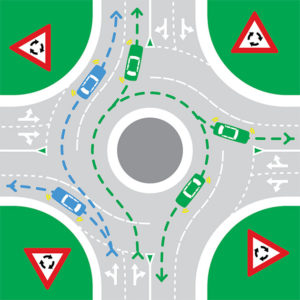If practical, you must always signal left when exiting a roundabout.

Making turns and giving way at roundabouts
The diagram shows how to indicate and give way at roundabouts:
- Approaching a roundabout: Vehicles entering a roundabout must give way to any vehicle already in the roundabout.
- Giving way at a roundabout: The driver must slow down and if necessary, stop to avoid a collision.
- Turning left: On your approach to a roundabout you must select the left lane, signal left, stay in the left lane to exit.
- Going straight ahead: Do not signal when approaching the roundabout but always signal left before exiting a roundabout. You may approach the roundabout from either left or right lanes (unless there are road markings with other instructions), drive in the same lane through the roundabout and exit in the same lane.
- Turning right: On your approach, to a roundabout you must select the right lane, signal right, stay in the right lane and signal left before exiting into the right lane.
- Making a U-turn: When you use the roundabout to make a U-turn on your approach signal right from the right lane, stay in the right lane, but signal left before exiting into the right lane.
- Exiting a roundabout: If practical, you must always signal left when exiting a roundabout.
Roundabouts and bicycle riders
Bicycle riders are allowed to turn right from the left hand lane. When passing each exit, the rider must give way to any vehicle leaving the roundabout from that exit.
Risks to watch for
Take extra care whenever you drive in a roundabout:
- Keep an eye out for cars that are leaving the roundabout
- Be careful if changing lanes in a roundabout, particularly when leaving
- Look out for vehicles that are making a full turn
- Watch for bicycles, long vehicles and motorcycles.
